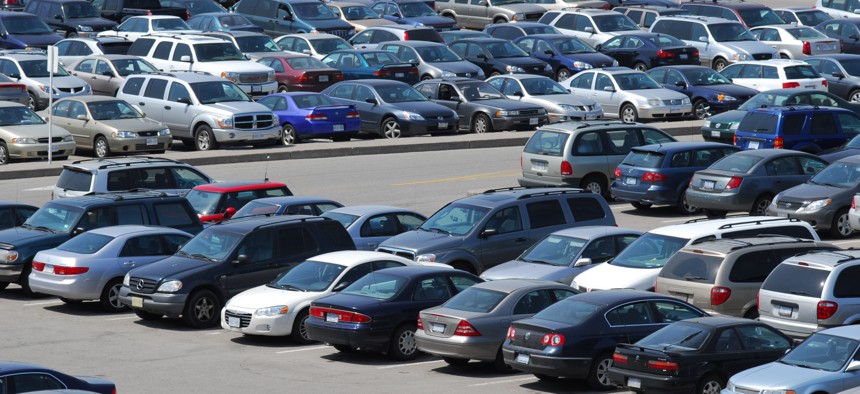A Glimpse Into America's Transportation Future

A crowded parking lot. Shutterstock
COMMENTARY | According to SpotHero CEO Mark Lawrence, Lyft’s $100 million investment in driver service centers "provides a snapshot of what a responsible future of urban mobility could look like."
Lyft’s recent announcement that they plan to invest $100 million into expanding driver service centers across the United States goes far beyond creating better conditions for drivers—and staying on a level playing field with Uber. I believe that the presence of these facilities will actually improve transit and infrastructure conditions for communities—and remove idle cars from their streets.
Ridesharing should remain complementary to public transportation and car ownership, not serve as a replacement. A sustainable future for the ridesharing industry entails providing needed relief for crowded city streets and creating an enduringly positive transit outlook for local communities around the country.
In reality, ridesharing is contributing to worsening road conditions, reduced funding and ridership for public transit and leading to more traffic and congestion. There is also a stark lack of transparency into the actual economic impact of ridesharing on cities, drivers and riders, respectively. That needs to change. We need ridesharing companies to transparently present the figures behind how the industry plays into a community’s transportation system—and to keep them accurate as the industry matures and hailing a rideshare becomes second nature to people.
That said, the ridesharing industry’s move toward providing value-added services to drivers through service centers is a promising step in the direction of community longevity. One that provides a snapshot of what a responsible future of urban mobility could look like—regardless of how regulatory battles play out and exactly when self-driving cars become mainstream. Private and public sector organizations that embrace technology, offer real estate for new services like those provided by Lyft’s centers and address congestion will be crucial to making all the pieces work together.
Future of parking
The conversation surrounding the future of mobility isn’t only about ridesharing and technological advancements to traditional modes of transit. It also needs to be about parking. In fact, 30% of city traffic on the road at any one time results from cars circling around looking for a place to park—or in ridesharing’s case, waiting for a rider to run down the block or come down from their apartment. Whether we’re talking about ridesharing, scooters, or flying taxis, they all have something in common: you need a place to park them. That won’t change.
But first, the parking industry needs to take steps to catch up with transportation technology—it’s still largely a pen and paper business, fragmented and regulated by local municipalities—which makes it complicated to innovate swiftly. Despite these challenges, parking innovation needs to be examined as part of the greater ridesharing and urban mobility equation. Technologies and platforms that connect people, vehicles and locations can reduce traffic and complement ridesharing service centers. They can help carmakers create better user experiences. They can save drivers time and money spent looking for riders or places to rest. They can help parking operators attract new customers and grow their businesses. And they can help cities drive more revenue for infrastructure maintenance.
To be clear, I do not share the view that the need for parking will diminish when self-driving cars hit the road in a meaningful way. However, I do see a demand similar to what’s brewing in today’s ridesharing world for value-adding services and infrastructure modernization materializing for autonomous vehicles. They will need to be refueled and/or recharged. They will need to have their interiors and exteriors cleaned. They will need to have their sensors calibrated. They will need to be repaired and maintained. They will need dedicated areas where those activities can take place.
Sharing roads through technology
It’s important for ridesharing companies, vehicle manufacturers, public officials, transit providers and riders to take a practical path toward improving shared infrastructure and mobility. And it’s important for everyone involved to understand that new industries might be created on top of existing ones to do so. For instance, there’s a growing need for fleet management services among traditional rideshare providers and alternative mobility companies working to alleviate vehicle traffic through alternative modes of transportation like bikes and scooters.
A central question arises: where do we put everything?
I believe that’s where off-street parking garages will come into play as key sources of space and utility for evolving personal transportation options. And rideshare service centers like the ones Lyft plans to build offer a model for parking operators to consider. New revenue streams from value-added services like charging, light maintenance and fleet management for alternative modes of transportation is where the $100 billion parking market should look to grow.
In the short-term, everyone involved needs to take steps to be more transparent about how initiatives like service centers and innovations like self-driving will actually impact drivers, riders and their communities. The biggest long-term challenge will be the adoption of—and compatibility between—ridesharing, autonomous and parking technologies that actually relieve traffic congestion, improve infrastructure conditions and help people get from point A to point B. Parking garages and off-street lots open to adopting new technologies and services will be in a solid position to respond on both fronts—and help mobile societies move forward.
Mark Lawrence is the Co-Founder and CEO of SpotHero, a national parking reservation service based in Chicago.
NEXT STORY: DARPA wants to simulate underground environments for robot testing





